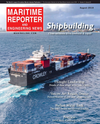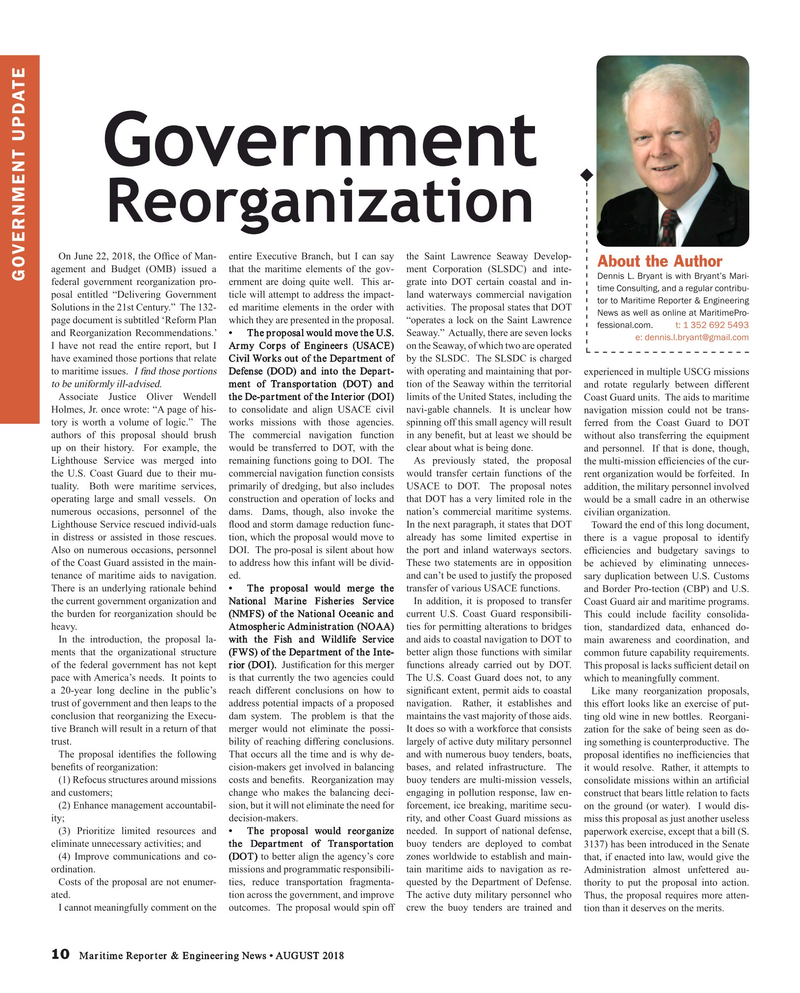
Page 10: of Maritime Reporter Magazine (August 2018)
The Shipyard Edition
Read this page in Pdf, Flash or Html5 edition of August 2018 Maritime Reporter Magazine
Government
Reorganization
On June 22, 2018, the Of? ce of Man- entire Executive Branch, but I can say the Saint Lawrence Seaway Develop-
About the Author agement and Budget (OMB) issued a that the maritime elements of the gov- ment Corporation (SLSDC) and inte-
Dennis L. Bryant is with Bryant’s Mari-
GOVERNMENT UPDATE federal government reorganization pro- ernment are doing quite well. This ar- grate into DOT certain coastal and in- time Consulting, and a regular contribu- posal entitled “Delivering Government ticle will attempt to address the impact- land waterways commercial navigation tor to Maritime Reporter & Engineering
Solutions in the 21st Century.” The 132- ed maritime elements in the order with activities. The proposal states that DOT
News as well as online at MaritimePro- page document is subtitled ‘Reform Plan which they are presented in the proposal. “operates a lock on the Saint Lawrence fessional.com. t: 1 352 692 5493 and Reorganization Recommendations.’ • The proposal would move the U.S. Seaway.” Actually, there are seven locks e: [email protected]
I have not read the entire report, but I Army Corps of Engineers (USACE) on the Seaway, of which two are operated have examined those portions that relate Civil Works out of the Department of by the SLSDC. The SLSDC is charged to maritime issues. I ? nd those portions Defense (DOD) and into the Depart- with operating and maintaining that por- experienced in multiple USCG missions to be uniformly ill-advised. ment of Transportation (DOT) and tion of the Seaway within the territorial and rotate regularly between different
Associate Justice Oliver Wendell the De-partment of the Interior (DOI) limits of the United States, including the Coast Guard units. The aids to maritime
Holmes, Jr. once wrote: “A page of his- to consolidate and align USACE civil navi-gable channels. It is unclear how navigation mission could not be trans- tory is worth a volume of logic.” The works missions with those agencies. spinning off this small agency will result ferred from the Coast Guard to DOT authors of this proposal should brush The commercial navigation function in any bene? t, but at least we should be without also transferring the equipment up on their history. For example, the would be transferred to DOT, with the clear about what is being done. and personnel. If that is done, though,
Lighthouse Service was merged into remaining functions going to DOI. The As previously stated, the proposal the multi-mission ef? ciencies of the cur- the U.S. Coast Guard due to their mu- commercial navigation function consists would transfer certain functions of the rent organization would be forfeited. In tuality. Both were maritime services, primarily of dredging, but also includes USACE to DOT. The proposal notes addition, the military personnel involved operating large and small vessels. On construction and operation of locks and that DOT has a very limited role in the would be a small cadre in an otherwise numerous occasions, personnel of the dams. Dams, though, also invoke the nation’s commercial maritime systems. civilian organization.
Lighthouse Service rescued individ-uals ? ood and storm damage reduction func- In the next paragraph, it states that DOT Toward the end of this long document, in distress or assisted in those rescues. tion, which the proposal would move to already has some limited expertise in there is a vague proposal to identify
Also on numerous occasions, personnel DOI. The pro-posal is silent about how the port and inland waterways sectors. ef? ciencies and budgetary savings to of the Coast Guard assisted in the main- to address how this infant will be divid- These two statements are in opposition be achieved by eliminating unneces- tenance of maritime aids to navigation. ed. and can’t be used to justify the proposed sary duplication between U.S. Customs
There is an underlying rationale behind • The proposal would merge the transfer of various USACE functions. and Border Pro-tection (CBP) and U.S. the current government organization and National Marine Fisheries Service In addition, it is proposed to transfer Coast Guard air and maritime programs. the burden for reorganization should be (NMFS) of the National Oceanic and current U.S. Coast Guard responsibili- This could include facility consolida- heavy. Atmospheric Administration (NOAA) ties for permitting alterations to bridges tion, standardized data, enhanced do-
In the introduction, the proposal la- with the Fish and Wildlife Service and aids to coastal navigation to DOT to main awareness and coordination, and ments that the organizational structure (FWS) of the Department of the Inte- better align those functions with similar common future capability requirements. of the federal government has not kept rior (DOI). Justi? cation for this merger functions already carried out by DOT. This proposal is lacks suf? cient detail on pace with America’s needs. It points to is that currently the two agencies could The U.S. Coast Guard does not, to any which to meaningfully comment.
a 20-year long decline in the public’s reach different conclusions on how to signi? cant extent, permit aids to coastal Like many reorganization proposals, trust of government and then leaps to the address potential impacts of a proposed navigation. Rather, it establishes and this effort looks like an exercise of put- conclusion that reorganizing the Execu- dam system. The problem is that the maintains the vast majority of those aids. ting old wine in new bottles. Reorgani- tive Branch will result in a return of that merger would not eliminate the possi- It does so with a workforce that consists zation for the sake of being seen as do- trust. bility of reaching differing conclusions. largely of active duty military personnel ing something is counterproductive. The
The proposal identi? es the following That occurs all the time and is why de- and with numerous buoy tenders, boats, proposal identi? es no inef? ciencies that bene? ts of reorganization: cision-makers get involved in balancing bases, and related infrastructure. The it would resolve. Rather, it attempts to (1) Refocus structures around missions costs and bene? ts. Reorganization may buoy tenders are multi-mission vessels, consolidate missions within an arti? cial and customers; change who makes the balancing deci- engaging in pollution response, law en- construct that bears little relation to facts (2) Enhance management accountabil- sion, but it will not eliminate the need for forcement, ice breaking, maritime secu- on the ground (or water). I would dis- ity; decision-makers. rity, and other Coast Guard missions as miss this proposal as just another useless (3) Prioritize limited resources and • The proposal would reorganize needed. In support of national defense, paperwork exercise, except that a bill (S. eliminate unnecessary activities; and the Department of Transportation buoy tenders are deployed to combat 3137) has been introduced in the Senate (4) Improve communications and co- (DOT) to better align the agency’s core zones worldwide to establish and main- that, if enacted into law, would give the ordination. missions and programmatic responsibili- tain maritime aids to navigation as re- Administration almost unfettered au-
Costs of the proposal are not enumer- ties, reduce transportation fragmenta- quested by the Department of Defense. thority to put the proposal into action. ated. tion across the government, and improve The active duty military personnel who Thus, the proposal requires more atten-
I cannot meaningfully comment on the outcomes. The proposal would spin off crew the buoy tenders are trained and tion than it deserves on the merits. 10 Maritime Reporter & Engineering News • AUGUST 2018
MR #8 (10-17).indd 10 MR #8 (10-17).indd 10 8/6/2018 9:30:12 AM8/6/2018 9:30:12 AM

 9
9

 11
11
